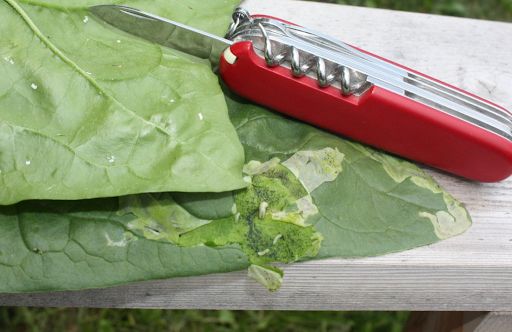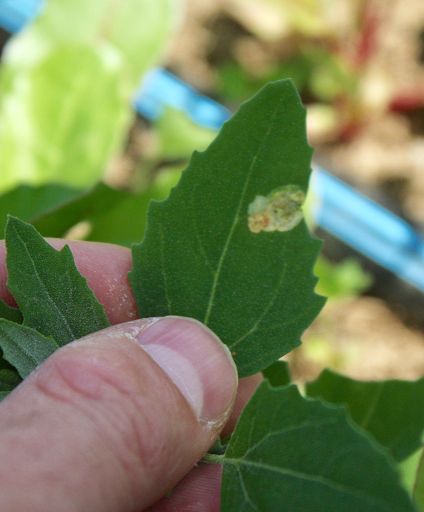
Pests: Spinach leafminer (Pegomya hyoscyami), Beet leafminer (Pegomya betae)
Pest/disease identification and lifecycle, most common symptoms and crops affected:
These closely related species of leafminer attack spinach, beet, chard and some weeds, such as lambsquarters. The adult is a fly that lays its eggs on the undersides of leaves. Eggs hatch in as few as three days, depending on temperature. The tiny, pale maggots tunnel into the interior of the leaf to feed, leaving pale mines that, when numerous, run together to form necrotic, blister-like areas. The damage is cosmetic, not impacting yield of beets, but it ruins the marketability of greens such as chard or spinach. When fully grown, larvae drop out of the leaf and pupate in the soil below. Leafminers have several generations, with the overwintering generation doing so in the soil as pupae, re-emerging the following spring as adult flies.
Management options:
Cultural:
Rotation is very important, especially when paired with the use of exclusion netting or row covers to exclude the adult fly, otherwise any overwintered pupae can emerge from the soil right where they want to be. Best practices include thorough harvesting where all leaves are removed, as well as destroying crops at the end of harvest to reduce the egg and larval population. Similarly, controlling weeds, especially lambsquarters, chickweed and plantain is important for reducing the nearby leafminer population, and subsequently the number of overwintering pupae. Deep plowing of soil harboring pupae attempting to overwinter can reduce the number of emerging flies the following spring.
Pesticides approved for use in certified organic production (as a last resort):
Because spinosad (e.g., Entrust for commercial growers, Monterey Garden Spray for gardeners) penetrates leaves to some extent, some farmers claim that it is effective against leafminers. It will be most effective if applied before eggs hatch and larvae enter the leaf.
Please note: This information is for educational purposes. Any reference to commercial products, trade or brand names is for information only, and no endorsement or approval is intended. Pesticide registration status, approval for use in organic production and other aspects of labeling may change after the date of this writing. It is always best practice to check on a pesticide’s registration status with your state’s board of pesticide control, and for certified organic commercial producers to update their certification specialist if they are planning to use a material that is not already listed on their organic system plan. The use of any pesticide material, even those approved for use in organic production, carries risk — be sure to read and follow all label instructions. The label is the law. Pesticides labeled for home garden use are often not allowed for use in commercial production unless stated as such on the label.



